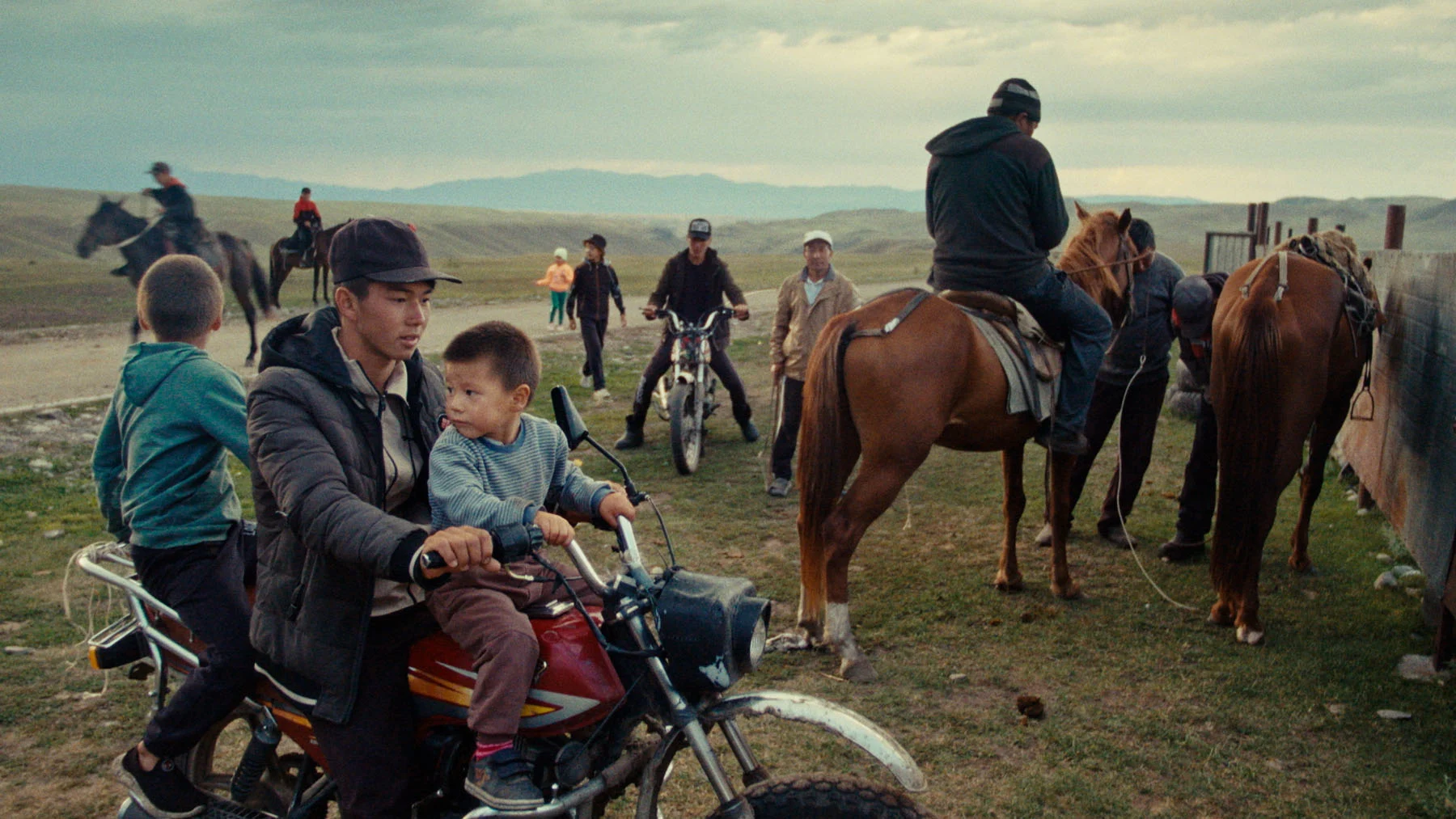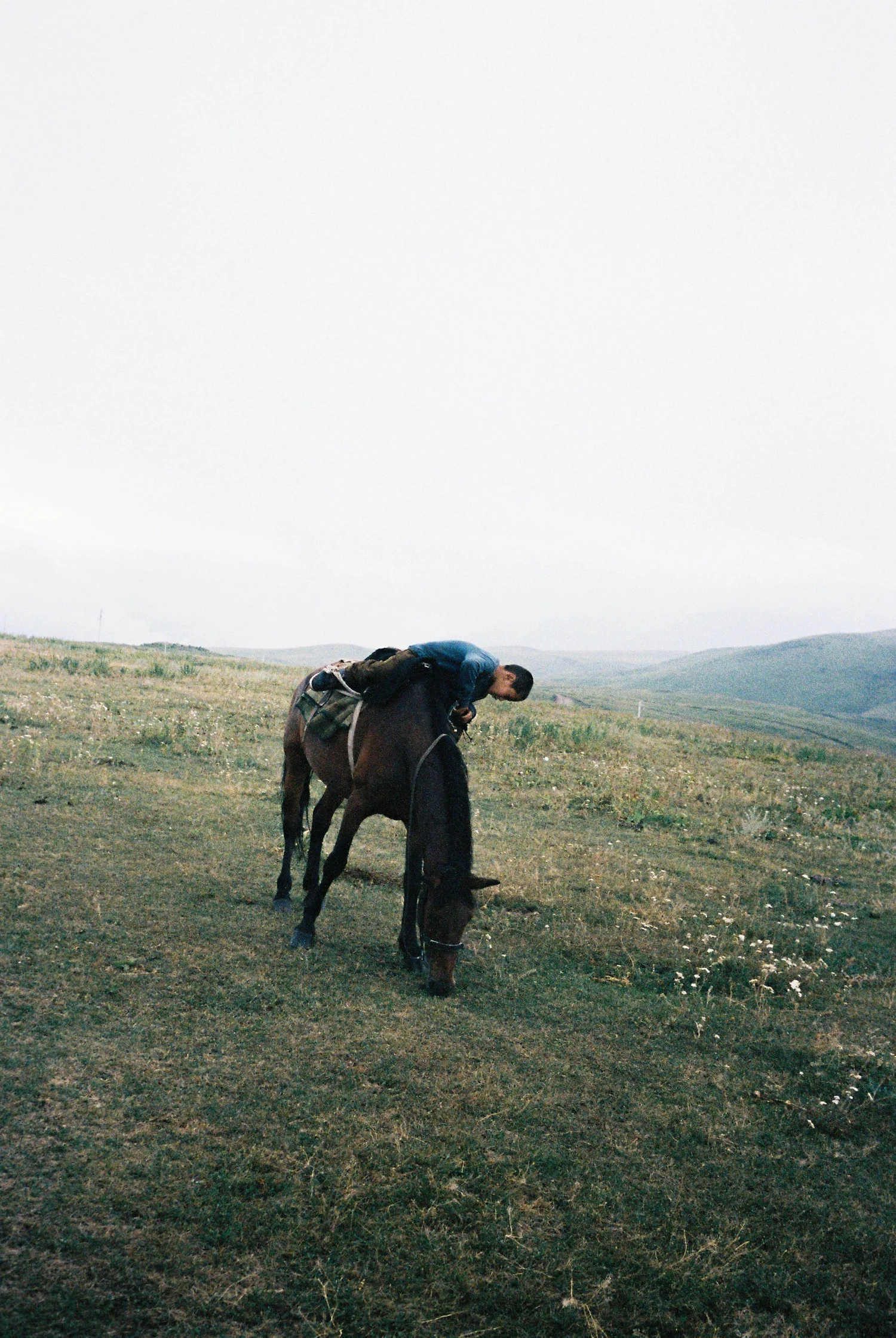

Kazakhstan has one of the highest populations of horses in the world, and the animal has been emblematic of the country—and vital to its people’s ancient lifestyle—for thousands of years. Filmmaker David Leon Fiene sought to explore this deep historic connection in “Astride,” a film (part of Matteo Guarnaccia’s “Cross-Cultural Chairs” project) that features native Kazakh people going about their everyday lives. He tells writer Dalia Al-Dujaili about how he weaved together stories from past and present to paint the horse saddle as the lifeblood of Kazakh culture.

A still life of men on horseback collectively praying before a sporting event. Horses standing alongside motorbikes at sunset, ancient and modern forms of transport complementing each other among the hilly terrain. In Kazakhstan, the horse is a dominant figure. Essential to the Kazakh’s ancient lifestyle, for years any luxury was always an equine one, such as a lavish saddle, boots or jewels to decorate horse tack. The horse has been the gateway for the evolution of Kazakh culture and many studies have suggested that the people of the Western Eurasian steppe are the earliest known riders. David Leon Fiene’s latest film “Astride” expresses the deep-rooted love affair between Kazakhs and their horses and documents the necessity of riding, in an exploration of what is essential to a culture.

Due to the Soviet Union’s occupation of Kazakhstan, “[Kazakh] songs, our stories and customs have been lost,” says one speaker introducing the film. “What remains are the stereotypes of Kazakh nomads created by the Soviet Union.” The general population speaks Russian, but Fiene tells me that younger generations are trying to bring elements of their former culture back, as well as relearning their native tongue. In “Astride,” he tried to capture individuals who were at the forefront of this minor cultural renaissance, and he was keen to include various generations and walks of life but all with a connection to horses and riding, in order to showcase the various ways Kazakh people interact with the animal and, subsequently, the saddle used to ride it.
Two characters who feature in the film are a famous Kokpar player, Rakhmatulla, and his wife Guldyan who speaks fondly about her childhood around horses. Kokpar is a game which involves several horse riders competing in two teams to get a decapitated and de-limbed goat’s carcass into the goal—not very kid friendly. Fiene collected two hours of footage with the pair as they “went on forever about Kokpar.” The relationship between Rahmatullah and his wife is a clear example of the cultural reverberations of riding horses in Kazakhstan and how deeply ingrained the art of riding is for local Kazakhs. Riding has been a source of joy, income and activity and even a way for the couple to foster love between one another.
Despite a deep love for filmmaking and photography, Fiene also works as a graphic and motion designer, which explains his multidisciplinary approach to creating. He composed “Astride” as a collection of smaller videos which he calls ‘story blocks,’ mixing still images (some of which saw Fiene’s team take a scanner to a wood artisan’s workshop in the mountains to acquire them), and video-essay elements, as the film moves beautifully from talking head interviews to moments of Kazakh quotidien life and landscapes, to image interruptions, such as archival images of horse saddles.
“Astride” was born from furniture designer Matteo Guarnaccia’s “Cross-Cultural Chairs” project, which involved designing chairs in the eight most populated countries in the world with the intention of intersecting design with anthropology, leading to an investigation of what we can learn about these cultures through the object of a chair; a universal need that is non-universal in how it takes shape from country to country. At the project’s end, the decision was made to extend the ideas into a workshop in 2022 with the help of Zhanna Ee in Kazakhstan, involving many creatives designing five horse saddles to signify the importance of engaging in local craft. The five final saddles can be seen in the film as they are being displayed in the Kazakhstan State Museum of Art.
I think cultures lie in between geographies and identities. Identity moves across borders and minds, representing territory and culture.
Fiene joined the project as an outsider capturing the creative process. “I really didn’t want to make a documentary capturing the workshop,” Fiene tells me. “I wanted it to be something more. I wanted it to show the process and the framework that Matteo developed to travel to another country and do this research and create an actual design, but I really wanted it to be about the Kazakh people and not so much about a group of European designers going to Kazakhstan and doing their thing.” With that in mind, the film shows shots of native Kazakh people in the city shopping for chandeliers, on motorbikes with their children, and tending to their livestock in the countryside.
“I think cultures lie in between geographies and identities, rarely as an isolated topic. Identity, like horse saddles, moves across borders and minds, representing territory and culture,” says Matteo at the beginning of the film. At its core, Astride is a film which takes a simple idea—chairs and sitting—and complicates it beautifully in a seemingly endless way, whereby the chair almost seems like the starting point of culture itself.

